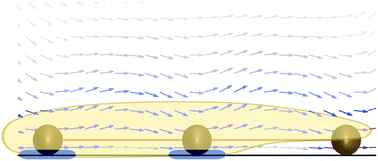Hydrodynamic effects on the motility of crawling eukaryotic cells†
Abstract
Eukaryotic cell motility is crucial during development, wound healing, the immune response, and cancer metastasis. Some eukaryotic cells can swim, but cells more commonly adhere to and crawl along the extracellular matrix. We study the relationship between hydrodynamics and adhesion that describe whether a cell is swimming, crawling, or combining these motions. Our simple model of a cell, based on the three-sphere swimmer, is capable of both swimming and crawling. As cell-matrix adhesion strength increases, the influence of hydrodynamics on migration diminishes. Cells with significant adhesion can crawl with speeds much larger than their nonadherent, swimming counterparts. We predict that, while most eukaryotic cells are in the strong-adhesion limit, increasing environment viscosity or decreasing cell-matrix adhesion could lead to significant hydrodynamic effects even in crawling cells. Signatures of hydrodynamic effects include a dependence of cell speed on the presence of a nearby substrate or interactions between noncontacting cells. These signatures will be suppressed at large adhesion strengths, but even strongly adherent cells will generate relevant fluid flows that will advect nearby passive particles and swimmers.



 Please wait while we load your content...
Please wait while we load your content...